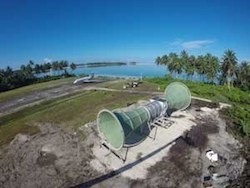The Nature Conservancy has installed the first phase of a bird friendly wind power project. The project is taking place in Palmyra, a national wildlife refuge located in Hawaii, where more than a million nesting seabirds call home. With low wind speeds, traditional wind turbines would have low output, plus, says the Conservancy, conventional wind turbines pose a risk of bird strikes. Thus, the group selected INVELOX, a funnel-based wind power technology developed by SheerWind.
The custom system is designed to mirror an hourglass laying on its side. Extending 83 feet horizontally with a big wind scoop at one end, an exhaust on the other, a Venturi section in the middle increases wind speed potentially three to six times. Nets over the intake and enclosed blades keep it bird friendly. The first phase of the installation includes a single turbine inside the Venturi, allowing for two additional to be installed.The first phase of the INVELOX project is successfully charging batteries at night, says The Nature Conservancy, and on cloudy days to supplement the photovoltaic system also installed on Palmyra.
“With a goal to reduce dependence on fossil fuels, SheerWind’s INVELOX was the only viable solution for the multiple restrictions including height, wind speeds, and of course bird populations. This solution works and helped bring the goal to reduce fossil fuel use a reality,” said The Nature Conservancy’s David Sellers, who is the driving force behind the design solution and details of the INVELOX installation.Palmyra Atoll is located 1,000 miles south of Hawaii in the vast equatorial Pacific, and hosts spectacular coral reef and tropical island ecosystems, but is a challenge for humans to inhabit. There are no commercial flights to this remote outpost, which is co-owned and managed as a scientific research station and national wildlife refuge by The Nature Conservancy and The U.S. Fish and Wildlife Service. Until the recent installation of wind and solar, Palmyra was run on diesel fuel generators. These installations reduced its dependence on fossil fuels by 95 percent according to The Nature Conservancy.
“We are grateful for David Sellers and The Nature Conservancy’s commitment to installing the first commercial system in an extremely challenging location. We are pleased we were able to contribute to this important achievement and hope this is an example to be duplicated globally,” added Dr. Daryoush Allaei, founder and CTO of SheerWind.



